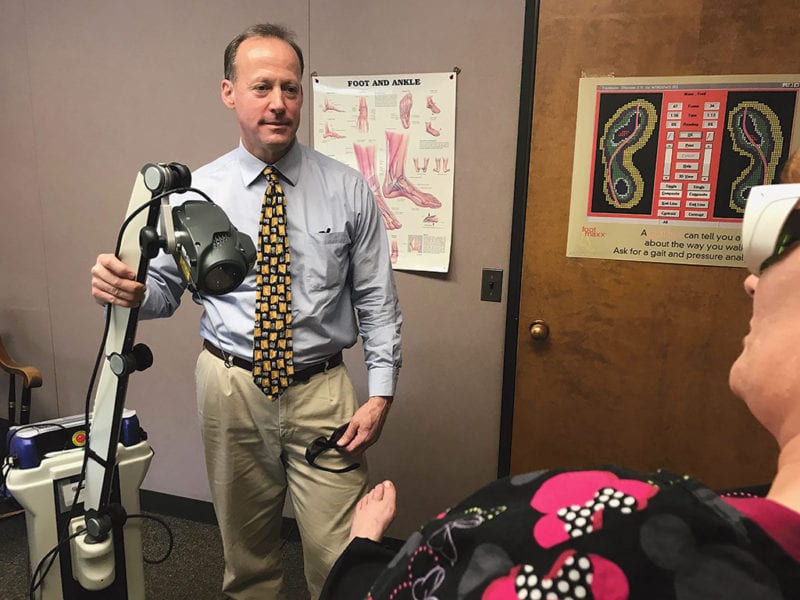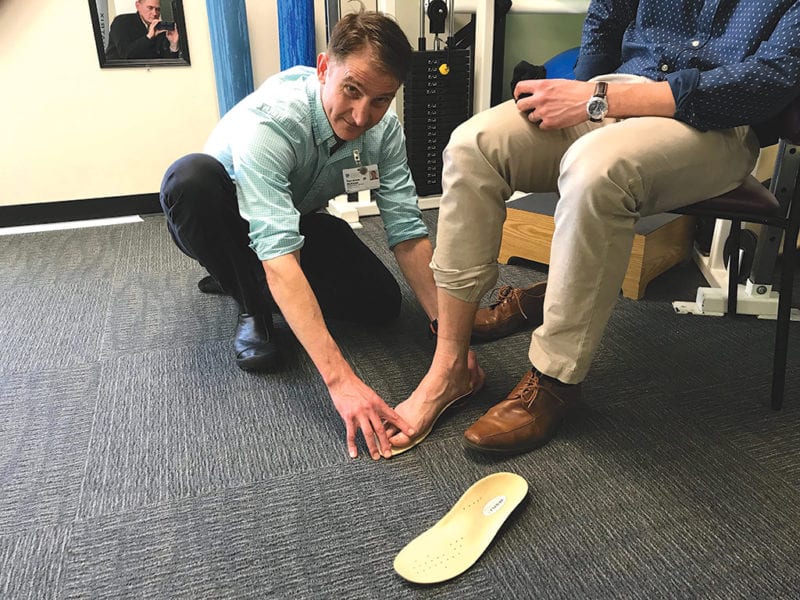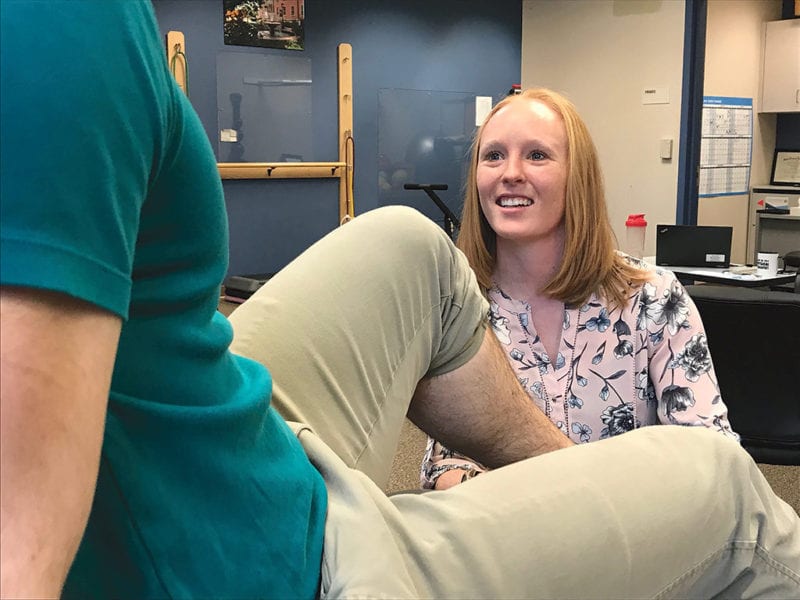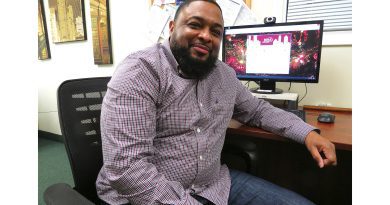It’s Easy, but Risky, to Overlook the Feet
Taking Important Steps
By Mark Morris
Spring weather in New England is a great time to shake off winter’s cabin fever and head outside to take a walk, go for a run, or play a sport. Spring also means an increase in foot injuries from people being too active, too soon.
While overdoing it can cause aches and pains in many areas of the body, it’s easy to overlook our feet, which support everything else and are key to overall quality of life. Those who specialize in this realm of care have a simple word of advice: don’t.
They stress the importance of taking care of one’s feet, listening to them when they are sore and need attention, and fully understanding how it’s not unusual for foot pain to be the cause or the result of other pain in the body.
“Sometimes foot pain causes knee, hip, or back issues, and by the same token, if someone has pain in their knees or back, it puts the foot in an awkward position, resulting in foot pain,” said Dr. Christopher Peteros, a podiatrist with New England Foot Specialists in Longmeadow, who stressed the importance of paying attention to pain, calling it our body’s early-warning system.
“If you feel pain in your foot, knee, or ankle, it’s telling you to stop what you’re doing,” he told HCN. “It’s like the ‘check engine’ light in your car.”
When we walk or run, the foot’s natural movement is known as pronation (the inward roll of the foot) and supination (the outward roll of the foot), both of which move us forward while providing support, cushioning, and balance. Too much or too little of either pronation or supination can cause pain in the feet and other parts of the body.
Terrance McKeon, a physical therapist with Cooley Dickinson Health Care’s Rehabilitation Services in South Deerfield, refers to the foot as the ‘victim,’ because it’s often the one in pain while the culprits can be nearby or as far away as the hip or pelvis. To carry the analogy further, McKeon said that, when investigating the cause of foot pain, the calf muscle is often a prime suspect, because when the calf muscles are tight, the body adjusts by collapsing the foot.

“Your foot tries to maintain balance by unnaturally scrunching the toes,” he explained. “Then the fascia gets stretched, the Achilles tendon gets overstretched, and you may even wiggle your pelvis, all because your calf muscles aren’t letting you get over your foot.”
Brianna Butcher, a physical therapist at Select Physical Therapy in Enfield, agreed. “When someone walks in with foot issues, the first thing I check is their hips,” she said, adding that, since the glute muscles tend to be weak in many people, it causes more strain to be put on the leg and foot to compensate and maintain balance.
For this issue and its focus on sports medicine, we take an in-depth look at what causes foot pain and discomfort and how to prepare your feet for activity.
Walking the Walk
Those who spoke with HCN there are a number of factors that contribute to one’s overall foot health — or lack thereof. These include everything from the level of exercise to the type and condition of the shoes being worn, to the surface that people walk or run on.

People should be thinking about all of them and making smart decisions, said Butcher, who noted, for example, that serious runners opt for an asphalt road instead of a concrete sidewalk, because the asphalt surface is slightly less harsh on our bodies than concrete.
“I’m not telling people to go walk in the middle of the street, but if you know of a neighborhood with a cul-de-sac or a circular street, those are better choices than sidewalks, which are a harder force on our bodies,” she said, adding that, for those who live near a track, that’s an even better option than walking on the street.
While sidewalks can be too hard on our feet, Peteros said treadmills can create the opposite problem and result in repetitive-motion injuries in the foot.
“Some treadmills can be too soft, so as your foot sinks in, it creates an abnormal amount of repeated pronation while the person is walking, which can lead to tendinitis or plantar fasciitis.”
One of the most common causes of foot pain, plantar fasciitis affects the band of tissue that runs along the bottom of the foot from heel to toe. The plantar fascia acts like a shock absorber to support the arch of the foot. Too much strain on it leads to a stabbing pain in the heel.
Many factors can contribute to plantar fasciitis, but it often results from a change in activity levels that puts more stress on the heel. Peteros said likely candidates for plantar fasciitis include the person who hasn’t run in years and then decides to pursue it again, as well as the person who goes on vacation and does more walking than normal while wearing flimsy shoes.
Peteros said a person with plantar fasciitis tends to experience severe pain in the morning after just waking up. The pain subsides a little after moving around, and then, by the end of the day, it increases. He said the pain can move into a cycle that won’t easily go away.
“It’s a very difficult thing to treat in some cases,” he said, “because you’re using that sore foot for every other step you take, unlike a sore hand where you can just carry it around.”
The first remedy Peteros suggests for plantar fasciitis and other foot injuries is the easy-to-remember acronym RICE: rest, ice, compression, and elevation. People can do this on their own, and in many cases RICE along with good, supportive shoes is enough to solve the problem. If that doesn’t work, he has a variety of treatments to further care for plantar fasciitis.
Anti-inflammatory medicines or cortisone shots are two possible treatment options. While cortisone can be effective for some, Peteros said, he cautions against its overuse because the shots can create ruptures in the plantar fascia instead of healing it.
For several years, he has used laser therapy to treat plantar fasciitis. As an alternative to anti-inflammatory medications, laser therapy uses a beam of light so it’s painless for the patient, works to reduce inflammation, and allows for faster healing. He said the success rate for healing injuries by laser therapy is about 80%.
“Depending on the injury, most patients will need between five and 10 treatments, which take about 10 minutes each. It may not always lead to a cure, but it speeds up the process,” he said.

For chronic foot issues, Peteros also uses shock-wave therapy, which treats plantar fasciitis with sound waves. He said it functions much like the technology that uses sound waves to break up kidney stones, adding that the same company makes the two machines.
When taken care of quickly, he said most people will get great results and no longer need treatment for their plantar fasciitis.
“Some patients may get an occasional flare-up, usually because they did something they shouldn’t have done. The key is to be aware of it, protect yourself, and stop as soon as you feel any pain.”
Getting to the Bottom of Things
That bit of advice applies to all aspects of foot care, said McKeon, who told HCN that, overall, it’s best to best to be proactive and avoid the energetic enthusiasm of taking too much advantage of a nice spring day.
“Your brain says, ‘I used to run five miles a day,’ but when you’ve gone all winter without running even one or two miles, that’s breaking the 10% rule,” he said, explaining that the best way to prevent injury when approaching spring activities is to take it easy in the beginning and gradually increase activity levels no more than 10% a week.
Physical therapists have used the 10% rule for years, and recent studies have supported the idea that the body can react and get stronger from a 10% increase each week for nearly any activity.
“If you can obey the rule, especially for weight-bearing activities like walking and running, you’ll be fine,” said McKeon.
This can require some pre-planning, he added, noting that simple heel-raising exercises for the calf muscles are a good way to get ready for a walking or jogging routine.
“Strengthening calf muscles is easy because you just go up and down on your toes. Go up on your toes to hit full height, then back down, and do them until you get tired,” he said, adding that the yoga position downward-facing dog is an effective exercise for tight calf muscles. He then stressed that the 10% rule also applies to the stretches.
As essential as good conditioning is to prevent foot injury, these proactive steps can easily be undone by cheap or worn-out shoes — or the wrong kind. McKeon said serious runners should consider new shoes every six months because the foam in the shoe that absorbs the energy of running will lose its ability to bounce back with heavy use.
Peteros also emphasized the importance of protecting the feet with good hygiene and proper shoes. “Whether you are a runner, walker, or any type of athlete, good, supportive shoes are the foundation of healthy feet.”
Peteros recommends shoes designed for the specific activity in mind, with a stiff sole. “If you can bend the shoe in half, it’s not offering support.”
One of the best examples of warm-weather shoes that provide no support are the ever-popular flip-flops. Peteros did not condemn them, necessarily, but referred to them as “purpose-built.”
“If you’re sitting around the pool, or at the beach, or even on your back deck with an iced tea, they’re perfectly fine to wear,” he said, adding that problems arise when people continually wear flip-flops around town, because the feet have to work hard just to keep them on. “Your toes are scrunching as they’re trying to grip the flip-flop, and there’s just no support; they’re actually more trouble than they’re worth.”
Peteros also mentioned the dangerous practice of people who wear flip-flops to mow the lawn, adding that yardwork is another place where good, supportive shoes matter.
“A lot of people retire their old, beat-up sneakers to wear in the yard, but when you’re doing yardwork, you’re often on uneven ground, when your feet need support the most.”
A work boot or hiking boot is a great choice for yardwork, he said, because they are lightweight and supportive. Meanwhile, high-top or low-cut shoes are both fine, he noted, stressing that these shoes should be kept just for yardwork; don’t retire them to the yard only after they’ve worn out.
Because every foot is different, people with overly high arches or flat feet often need additional support from custom orthotic inserts. Peteros admits that some people can get good results with over-the-counter insoles and advised that, when shopping for inserts, firmer is better. When a custom orthotic insert is needed, he said the old methods to make them have given way to 3-D digital imaging that results in an orthotic that fits the exact contours of the person’s foot.
“We used to make casts and molds and have people step in foam. I haven’t done those things in at least nine years; it’s all digital now.”
McKeon said finding the right footwear for those at one extreme or another can be tricky, while people whose feet are more in the middle range may be able to slowly build up strength in their feet and avoid using an insert.
“I tell people that, if they gradually increase their activity levels following the 10% rule, they can improve the strength in their foot,” he explained. “This works well with athletes who don’t like wearing orthotic inserts.”
So, before taking on outdoor activities this spring, remember supportive shoes, the 10% rule, and RICE. You’ll prevent injury to your feet and better enjoy the spring weather. v



